
Oxfordian stage
Encyclopedia
The Oxfordian is, in the ICS
' geologic timescale, the earliest age of the Late Jurassic
epoch
, or the lowest stage of the Upper Jurassic series
. It spans the time between 161.2 ± 4 Ma and 155.7 ± 4 Ma (million years ago). The Oxfordian is preceded by the Callovian
and is followed by the Kimmeridgian
.
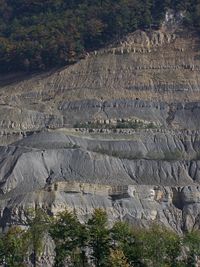 The Oxfordian stage was introduced into scientific writing by Alexandre Brongniart
The Oxfordian stage was introduced into scientific writing by Alexandre Brongniart
in 1827. The stage takes its name from the city of Oxford
in England
.
The base of the Oxfordian stage is defined as the point in the stratigraphic record where the ammonite
species Brightia thuouxensis first appears. A global reference profile for the base (a GSSP) had in 2009 not yet been assigned. The top of the Oxfordian stage (the base of the Kimmeridgian) is at the first appearance of ammonite
species Pictonia baylei.
In the Tethys domain
, the Oxfordian contains six ammonite biozone
s:
.
International Commission on Stratigraphy
The International Commission on Stratigraphy , sometimes referred to by the unofficial "International Stratigraphic Commission" is a daughter or major subcommittee grade scientific daughter organization that concerns itself with stratigraphy, geological, and geochronological matters on a global...
' geologic timescale, the earliest age of the Late Jurassic
Late Jurassic
The Late Jurassic is the third epoch of the Jurassic Period, and it spans the geologic time from 161.2 ± 4.0 to 145.5 ± 4.0 million years ago , which is preserved in Upper Jurassic strata. In European lithostratigraphy, the name "Malm" indicates rocks of Late Jurassic age...
epoch
Epoch (geology)
An epoch is a subdivision of the geologic timescale based on rock layering. In order, the higher subdivisions are periods, eras and eons. We are currently living in the Holocene epoch...
, or the lowest stage of the Upper Jurassic series
Series (stratigraphy)
Series are subdivisions of rock layers made based on the age of the rock and corresponding to the dating system unit called an epoch, both being formally defined international conventions of the geological timescale. A series is therefore a sequence of rock depositions defining a...
. It spans the time between 161.2 ± 4 Ma and 155.7 ± 4 Ma (million years ago). The Oxfordian is preceded by the Callovian
Callovian
In the geologic timescale, the Callovian is an age or stage in the Middle Jurassic, lasting between 164.7 ± 4.0 Ma and 161.2 ± 4.0 Ma. It is the last stage of the Middle Jurassic, following the Bathonian and preceding the Oxfordian....
and is followed by the Kimmeridgian
Kimmeridgian
In the geologic timescale, the Kimmeridgian is an age or stage in the Late or Upper Jurassic epoch or series. It spans the time between 155.7 ± 4 Ma and 150.8 ± 4 Ma . The Kimmeridgian follows the Oxfordian and precedes the Tithonian....
.
Stratigraphic definitions

Alexandre Brongniart
Alexandre Brongniart was a French chemist, mineralogist, and zoologist, who collaborated with Georges Cuvier on a study of the geology of the region around Paris...
in 1827. The stage takes its name from the city of Oxford
Oxford
The city of Oxford is the county town of Oxfordshire, England. The city, made prominent by its medieval university, has a population of just under 165,000, with 153,900 living within the district boundary. It lies about 50 miles north-west of London. The rivers Cherwell and Thames run through...
in England
England
England is a country that is part of the United Kingdom. It shares land borders with Scotland to the north and Wales to the west; the Irish Sea is to the north west, the Celtic Sea to the south west, with the North Sea to the east and the English Channel to the south separating it from continental...
.
The base of the Oxfordian stage is defined as the point in the stratigraphic record where the ammonite
Ammonite
Ammonite, as a zoological or paleontological term, refers to any member of the Ammonoidea an extinct subclass within the Molluscan class Cephalopoda which are more closely related to living coleoids Ammonite, as a zoological or paleontological term, refers to any member of the Ammonoidea an extinct...
species Brightia thuouxensis first appears. A global reference profile for the base (a GSSP) had in 2009 not yet been assigned. The top of the Oxfordian stage (the base of the Kimmeridgian) is at the first appearance of ammonite
Ammonite
Ammonite, as a zoological or paleontological term, refers to any member of the Ammonoidea an extinct subclass within the Molluscan class Cephalopoda which are more closely related to living coleoids Ammonite, as a zoological or paleontological term, refers to any member of the Ammonoidea an extinct...
species Pictonia baylei.
In the Tethys domain
Tethys Ocean
The Tethys Ocean was an ocean that existed between the continents of Gondwana and Laurasia during the Mesozoic era before the opening of the Indian Ocean.-Modern theory:...
, the Oxfordian contains six ammonite biozone
Biozone
Biostratigraphic units or Biozones are intervals of geological strata that are defined on the basis of their characteristic fossil taxa....
s:
- zone of Epipeltoceras bimammatum
- zone of Perishinctes bifurcatus
- zone of Gregoryceras transversarium
- zone of Perisphinctes plicatilisPerisphinctesPerisphinctes is an extinct genus of ammonite cephalopod. They lived during the Jurassic Period , and serve as an index fossil for that time period....
- zone of Cardioceras cordatum
- zone of Quenstedtoceras mariae
†Ornithischians
| Ornithischians of the Oxfordian | ||||
|---|---|---|---|---|
| Taxa | Presence | Location | Description | Images |
|
Oxfordian? Tithonian Tithonian In the geologic timescale the Tithonian is the latest age of the Late Jurassic epoch or the uppermost stage of the Upper Jurassic series. It spans the time between 150.8 ± 4 Ma and 145.5 ± 4 Ma... ? |
Chaoyang, Liaoning, China | A marginocephalian dinosaur from the Late Jurassic of China, belonged to the Ceratopsia, a group of primarily herbivorous dinosaurs with parrot-like beaks | 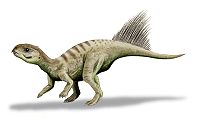  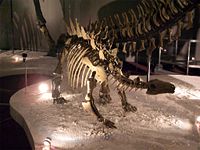    |
|
Upper Shaximiao Formation, Sichuan, China | A genus of stegosaur similar to Kentrosaurus | ||
|
Chungkingosaurus Chungkingosaurus, meaning "Chongqing Lizard", is a genus of dinosaur from the Late Jurassic-age Upper Shaximiao Formation in what is now China. It is classified as a stegosaurid.-Discovery and species:... |
Upper Shaximiao Formation, Sichuan, China | One of the smallest of the stegosaurids at 3-4 metres long (10-13 ft), Chungkingosaurus had at least five spikes on its thagomizer. It had a rather high and narrow skull and large, thick bony plates. | ||
|
Dacentrurus Dacentrurus , originally known as Omosaurus, was a large stegosaur of the Late Jurassic Period .-Description:... |
England, France, Spain, Portugal | A large stegosaurid | ||
|
Eugongbusaurus "Eugongbusaurus" is the informal name given to a genus of dinosaur that lived about 160 to 155 million years ago, in the Late Jurassic. It was either a hypsilophodont, or a less-derived ornithischian... " |
Shishugou Formation Shishugou Formation The Shishugou Formation is a geological formation in Xinjiang, China, whose strata date back to the Late Jurassic period. Dinosaur remains are among the fossils that have been recovered from the formation.... , Xinjiang, China |
Either a hypsilophodont, or a less-derived ornithischian | ||
|
Gongbusaurus Gongbusaurus is a genus of ornithischian, perhaps ornithopod, dinosaur that lived between about 160 and 155 million years ago, in the Late Jurassic period. A small herbivore, it is very poorly known. Two species have been assigned to it, but as the original name is based on teeth, there is no... |
Dashanpu Formation Dashanpu Formation The Dashanpu Formation is a Mid to Late Jurassic rock formation in China, most notable for the wealth of dinosaurs that have been excavated from the area... , Sichuan, China |
By extrapolation from the remains of possible species and other basal ornithopods, it was a herbivorous bipedal animal around 1.3 to 1.5 meters long (4.3 to 4.9 ft). It would have been a strong runner | ||
|
Jiangjunosaurus Jiangjunosaurus is a genus of stegosaurid dinosaur from the Oxfordian-age Shishugou Formation of the Junggar Basin, Xinjiang, China. Remains including the lower jaw, some skull bones, eleven articulated neck vertebrae, and two plates are known. The type species, J. junggarensis, was described by... |
Junggar Basin, Xinjiang, China | A genus of stegosaurid | ||
|
Tuojiangosaurus Tuojiangosaurus is a genus of stegosaurid dinosaur from the Late Jurassic Period, recovered from the Upper Shaximiao Formation of what is now Sichuan Province in China. Physically similar to the North American Stegosaurus, Tuojiangosaurus is the best understood of the Chinese stegosaurids... |
Upper Shaximiao Formation, Sichuan, China | The best understood of the Chinese stegosaurs. It was around 7.0 meters (23 ft) long and 2 meters (7 ft) high, with a postulated weight of around 4 metric tons (4.4 short tons). | ||
|
Yinlong Yinlong is a genus of basal ceratopsian dinosaur from the Late Jurassic Period of central Asia. It was a small, primarily bipedal herbivore, approximately 1.2 meters long... |
Shishugou Formation Shishugou Formation The Shishugou Formation is a geological formation in Xinjiang, China, whose strata date back to the Late Jurassic period. Dinosaur remains are among the fossils that have been recovered from the formation.... , Xinjiang, China |
A small, primarily bipedal herbivore, approximately 1.2 meters (4 ft) long, the oldest and most primitive ceratopsian known to science. | ||
†Thalattosuchians
| Thalattosuchians of the Oxfordian | ||||
|---|---|---|---|---|
| Taxa | Presence | Location | Description | Images |
|
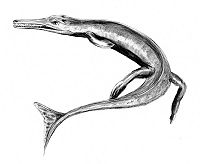  |
|||
|
||||
|
Metriorhynchus Metriorhynchus is an extinct genus of marine crocodyliform that lived in the oceans during the Middle to Late Jurassic. Metriorhynchus was named by the German palaeontologist Christian von Meyer in 1830. Metriorhynchus was a carnivore that spent much, if not all, its life out at sea... |
An opportunistic carnivore Carnivore A carnivore meaning 'meat eater' is an organism that derives its energy and nutrient requirements from a diet consisting mainly or exclusively of animal tissue, whether through predation or scavenging... that fed on fish Fish Fish are a paraphyletic group of organisms that consist of all gill-bearing aquatic vertebrate animals that lack limbs with digits. Included in this definition are the living hagfish, lampreys, and cartilaginous and bony fish, as well as various extinct related groups... , belemnites and other marine animals and possible carrion. Metriorhynchus grew to an average adult length of 3 meters (9.6 feet), although some individuals may have reached lengths rivaling those of large nile crocodile Nile crocodile The Nile crocodile or Common crocodile is an African crocodile which is common in Somalia, Ethiopia, Uganda, Kenya, Egypt, Tanzania, Zambia, Zimbabwe, Gabon, South Africa, Malawi, Sudan, Botswana, and Cameroon... s. |
|||
|
Steneosaurus Steneosaurus is an extinct genus of teleosaurid crocodyliform from the Early Jurassic to Early Cretaceous . Fossil specimens have been found in England, France, Germany, Switzerland and Morocco.-Species:... |
||||
Theropods
| Theropoda Theropoda Theropoda is both a suborder of bipedal saurischian dinosaurs, and a clade consisting of that suborder and its descendants . Dinosaurs belonging to the suborder theropoda were primarily carnivorous, although a number of theropod groups evolved herbivory, omnivory, and insectivory... of the Oxfordian |
||||
|---|---|---|---|---|
| Taxa | Presence | Location | Description | Images |
|
Upper Shaximiao Formation, Sichuan, China | Yangchuanosaurus shangyouensis reached about 7 meters long (23 ft) with a skull around 80 cm long (32 in). Its relative Y. magnus grew larger still: up to 10 meters long (33 ft) with a skull up to 1 metre (3 ft) in length. There was a bony knob on its nose and multiple hornlets and ridges, similar to Ceratosaurus. It had a massive tail that was about half its length. | ||
|
Monolophosaurus Monolophosaurus was a genus of theropod dinosaur from the Middle Jurassic of the Shishugou Formation in what is now Xinjiang, China. It was named for the single crest on top of its skull. The type and only known individual is estimated at... |
Upper Shaximiao Formation, China | Monolophosaurus was a medium sized predator that grew to at least 5.7 meters (19 ft) long. It had an odd, unique crest on its head which ran most of the length of the skull. | 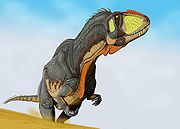 |
|
Nautiloids
| Nautiloids of the Oxfordian | ||||
|---|---|---|---|---|
| Taxa | Presence | Location | Description | Images |
|
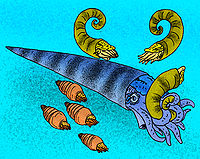 |
|||
†Belemnites
| Belemnites of the Oxfordian | ||||
|---|---|---|---|---|
| Taxa | Presence | Location | Description | Images |
|
||||
Literature
; 1829: Tableau théorique de la succession et de la disposition la plus générale on Europa, des terrains et roches, qui composent l'écorce de la terre, Paris.; 2004: A Geologic Time Scale 2004, Cambridge University PressCambridge University Press
Cambridge University Press is the publishing business of the University of Cambridge. Granted letters patent by Henry VIII in 1534, it is the world's oldest publishing house, and the second largest university press in the world...
.
External links
- GeoWhen Database - Oxfordian
- Jurassic-Cretaceous timescale, at the website of the subcommission for stratigraphic information of the ICS
- Stratigraphic chart of the Upper Jurassic, at the website of Norges Network of offshore records of geology and stratigraphy

